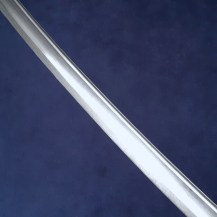Swiss M1852 Cavalry Trooper’s Sword
Curved blade with hatchet point, with a long central fuller and shorter narrow fuller near the spine of the blade (a la Montmorency). Brass hilt with central knucklebow and two side bars, spiral ribbed grip of pressed black leather over wood. Steel scabbard with two hanging rings. Blade 36 inches in length, the sword 42 inches overall.
The blade is stamped at the ricasso on one side with the maker’s mark ‘Gebr: Weyersberg’, and on the other side with ‘Solingen’ indicating the manufacturer Gebrüder Weyersberg (Weyersberg Brothers). Founded by the brothers Wilhem, Peter and Johann Ludwig Weyersberg in 1787, this major Solingen-based firm merged with W. R. Kirschbaum & Co in 1883, forming the even larger Weyersberg, Kirschbaum & Co. which still exists today as WKC Stahl- und Metallwarenfabrik.
The blade is also stamped in the fuller on one side with a crown over ‘AA’, the arsenal stamp of Bern, Switzerland, and the serial number ‘1060’.
The French M1822 Light Cavalry sabre proved to be an extremely popular design. It was adopted by Belgium in 1834 after its independence from the Netherlands. The United States also adopted this sword as the Model 1840, and surplus French-made swords were sold to Poland and Finland in the 1920s. The Swiss initially adopted it as the M1842 - this example is the later M1852, which lacks the clipped point of its predecessor. The Swiss contracted production of the blades to firms in Solingen, Germany. I have also seen examples marked to Clemen & Jung, so the contracts were probably spread across multiple manufacturers.
The blade is bright with only a few tiny spots of patination, a few nicks to the edge towards the point (beyond the end of the fuller). The brass hilt has a dark patina which I have left untouched. The grip’s wire binding has been lost, aside from a few stubs at the pommel end. The grip leather is intact with light handling wear. The scabbard is free of dents and is bright with some patination in the recesses.



























